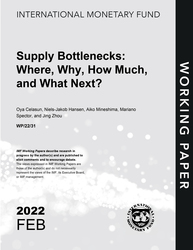
Supply Bottlenecks: Where, Why, How Much, and What Next?
Supply Bottlenecks: Where, Why, How Much, and What Next?
READ MORE...
Volume/Issue:
Volume 2022
Issue 031
Publication date: February 2022
ISBN: 9798400202476
$5.00
Add to Cart by clicking price of the language and format you'd like to purchase
Available Languages and Formats
| English |
Prices in red indicate formats that are not yet available but are forthcoming.
Topics covered in this book
This title contains information about the following subjects.
Click on a subject if you would like to see other titles with the same subjects.
Inflation , Labor , Economics- Macroeconomics , Economics / General , Industries - Manufacturing , Output , Inflation , Manufacturing , Supply Constraints , PPI inflation , producer price inflation , supply-shock contribution , chip shortage , industry expert , Supply shocks , Producer price indexes , Labor shortages , Global
Summary
Supply constraints hurt the economic recovery and boosted inflation in 2021. We find that in the euro area, manufacturing output and GDP would have been about 6 and 2 percent higher, respectively, and half of the rise in manufacturing producer price inflation would not have occurred in the absence of supply bottlenecks. Globally, shutdowns can explain up to 40 percent of the supply shocks. Sectors that are more reliant on differentiated inputs—such as autos—are harder hit. Late last year industry experts expected supply shortages for autos to largely dissipate by mid-2022 and broader bottlenecks by end-2022, but given the Omicron wave, disruptions will last for longer, possibly into 2023. With supply constraints adding to price pressures, the challenge for policymakers is to support recovery without allowing high inflation to become entrenched.
Copyright © 2010 - 2025
Powered by:
AIDC



